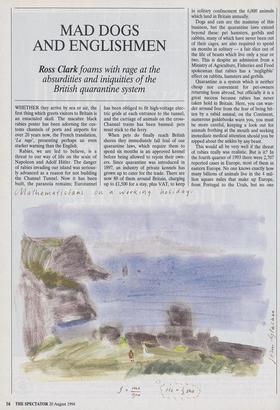MAD DOGS AND ENGLISHMEN
Ross Clark foams with rage at the
absurdities and iniquities of the British quarantine system
WHETHER they arrive by sea or air, the first thing which greets visitors to Britain is an emaciated skull. The macabre black rabies poster has been adorning the cus- toms channels of ports and airports for over 20 years now, the French translation, 'La rage', presenting perhaps an even starker warning than the English.
Rabies, we are led to believe, is a threat to our way of life on the scale of Napoleon and Adolf Hitler. The danger of rabies invading our island was serious- ly advanced as a reason for not building the Channel Tunnel. Now it has been built, the paranoia remains; Eurotunnel has been obliged to fit high-voltage elec- tric grids at each entrance to the tunnel, and the carriage of animals on the cross- Channel trains has been banned: pets must stick to the ferry.
When pets do finally reach British shores they immediately fall foul of our quarantine laws, which require them to spend six months in an approved kennel before being allowed to rejoin their own- ers. Since quarantine was introduced in 1897, an industry of private kennels has grown up to cater for the trade. There are now 80 of them around Britain, charging up to £1,500 for a stay, plus VAT, to keep in solitary confinement the 6,000 animals which land in Britain annually.
Dogs and cats are the mainstay of this business, but the quarantine laws extend beyond these: pet hamsters, gerbils and rabbits, many of which have never been out of their cages, are also required to spend six months in solitary — a fair slice out of the life of beasts which live only a year or two. This is despite an admission from a Ministry of Agriculture, Fisheries and Food spokesman that rabies has a 'negligible' effect on rabbits, hamsters and gerbils.
Quarantine is a system which is neither cheap nor convenient for pet-owners returning from abroad, but officially it is a great success because rabies has never taken hold in Britain. Here, you can wan- der around free from the fear of being bit- ten by a rabid animal; on the Continent, numerous guidebooks warn you, you must be more careful, keeping a look out for animals frothing at the mouth and seeking immediate medical attention should you be nipped about the ankles by any beast.
This would all be very well if the threat of rabies really was realistic. But is it? In the fourth quarter of 1993 there were 2,707 reported cases in Europe, most of them in eastern Europe. No one knows exactly how many billions of animals live in the 4 mil- lion square miles that make up Europe, from Portugal to the Urals, but no one could pretend that an annual total of around 10,000 cases makes rabies anything other than a rare disease in Europe, even among animals. As for humans, no western European contracted rabies last year, although there were three cases reported in Russia. The few Europeans who have suffered rabies in the recent past have picked it up in the Third World. The last Briton to contract it, in 1988, was bitten by a dog in India.
Few British pets brought to this country seem ever to have suffered from rabies either. Telephone calls to a random selec- tion of the 80 approved quarantine kennels failed to reveal a single recorded case of the disease. A large kennel near Heathrow airport, which has been in business for 30 years and takes 140 dogs at a time, report- ed 'a few suspected rabies cases' but no real ones. An 85-berth kennel at Alton, Hampshire, had not seen a single case in 35 years. And so it went on.
Eventually, I unearthed Lady Spencer- Smith, who, with her husband Sir John, runs the Hazel House Quarantine Kennels at Elsted, near Midhurst, Sussex. Here it was in 1990 that the last case of rabies in Britain was reported. The dog in question had been brought back from Zambia, where it had never exhibited any symptoms of rabies. Before it came to Britain it was injected with a 'live' vaccine; shortly after it arrived, on 4 July, it was administered a second, 'dead' vaccine. One month later, on 4 August, it showed its first symptom of rabies, a stiffness in the back muscles. The animal's condition steadily worsened and, on 6 September, it was finally put down.
However, government vets now believe that the animal may not have been a victim of rabies itself, but was suffering from an adverse reaction from the 'live' anti-rabies vaccine it was given as a puppy. A live vac- cine is, in fact, a live dose of the rabies virus, which is known to cause the disease when administered to certain animals.
The dog which died in Sussex in 1990 had come from Zambia. As for dogs brought here from western Europe, none has been found to be suffering from rabies since 1969, when a German dog called Fritz died at quarantine kennels at Cae- sar's Camp near Folkestone. The case caused a scare at the time, leading to the Waterhouse Report on rabies in 1971. But it was subsequently discovered that Fritz contracted the disease not in Germany but in Folkestone, infected by a dog in one of the neighbouring kennels.
So why are British pet-owners having to pay £10 million a year to support the quar- antine kennel industry instead of enjoying free movement of their animals within the European Union? If the animals have been properly vaccinated, what is there to fear? Surely unnecessary quarantine is the kind of restriction the single market was supposed to stop.
One thing for sure is that with our quar- antine laws it is humbug for us to object to the ban on British beef imports imposed by Germany earlier this year and since lifted. In contrast to the 2,707 cases of rabies reported over the whole of Europe in the last quarter of 1993, Britain last year recorded 34,363 cases of mad cow disease, the degenerative brain disorder properly known as Bovine spongiform encephalopathy. Meanwhile, the human form of the illness, Creutzfeldt-Jakob disease, a debilitating disease which may be transmittable from cattle to man, claimed 26 victims in Britain last year and 44 in 1992. Com- pare this with zero cases of rabies in western Europe last year.
Of course rabies is not a disease to be taken lightly. If it is contracted by humans, and an antidote is not given in time, it promises a uniquely horrible death. Accounts of sufferers writhing in agony, frothing at the mouth, quickly dehydrat- ing, probably do as much to maintain the quarantine laws as any statistics from the World Health Organisation.
But when it comes face to face with a genuine rabies threat, the Government's vets are not always as quick to move as one might imagine. Four years ago, Guy Tamplin, chairman of the Quarantine Kennel Owners' Association, found him- self with a suspected rabies case at his kennels at Newnham upon Severn, Gloucestershire. The animal, a dog, had been captured running along the quayside at Newport, having been let loose by the crew of a Far Eastern timber freighter which had adopted it as a pet. By the time the dog arrived at Mr Tamplin's kennels it was salivating and barking madly.
The traditional method of dealing with a mad dog is straightforward: you shoot the beast before it has the chance to bite anyone. Mr Tamplin says he was not allowed to do this; the dog was only a suspected rabies case — the reason for this, says Mr Tamplin, was that none of the vets who look after his animals was prepared to go near the dog to complete a diagnosis — and the owners were allowed to have it back if they wished. And they did want it back. So, after 11 days spent salivating in Mr Tamplin's kennels, the dog had to be coaxed into a box and flown out to Gibraltar, as air cargo, to be reunited with the freighter crew. 'The Ministry wasn't terribly involved,' says Mr Tamplin.
What the MAFF has involved itself in, however, is the installation of numerous anti-rabies devices in the Channel Tunnel, despite the fact that rabies is no more active at the other end of the 35-mile tun- nel in the Pas de Calais.
Perhaps it is better to err on the safe side, to take excessive precautions rather than risk a nasty disease. But, in that case, with 34,363 cows dying of BSE last year, why is anyone still allowed to eat British beef?



















































 Previous page
Previous page